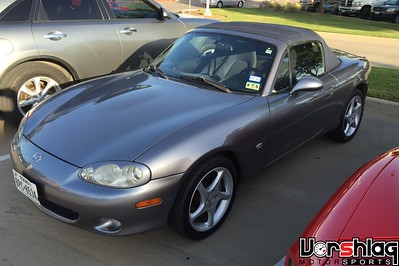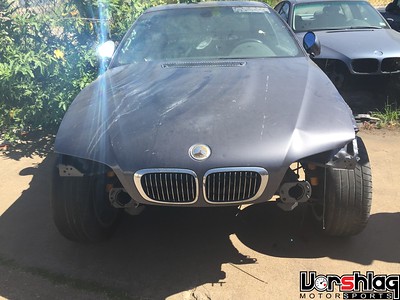continued from above


Mr Chainsaw thought about a McLaren, but wanted something that could be built faster for less, and more unique. Once we had a detailed build plan and estimate for this V8 M3, we then cautioned him that driving this car would be fairly difficult. Jason convinced him to let us build him a "trainer car" to help sharpen his skills on track. The supercharged Mustang making 640 whp and was a just a damn
missile on track, using the power to pass anything on the straights.
A stock powered 1.8L NB Miata would teach him how to maximize corner speeds, braking, and patience! He set his ego aside and gave us the go in the Summer of 2015. Jason and I found this 2003 Miata and our team turned it into a trainer with full safety (cage, seat, harnesses, fire, remote kill switches), excellent suspension (MCS, Hyperco, Vorshlag + bushings, bars), upgraded brakes (NB Sport brakes, Vorshlag lines, custom cooling, G-LOC pads, Motul fluid) and track worthy wheels/tires (17x8" Enkei & 225mm Rival-S), and lots of cooling (Mishimoto rad, custom oil cooler, new water pump & hoses, etc).

The goal of the track trainer was a super reliable car that he (and others in his family) could use to "beat on like a rented mule" at track events, to improve and refine driving skills. He hired a driving coach/data analyst as well. We built this car in 17 days and it was actually quite a fun little project to be able to do a Miata "right".


Jon here at Vorshlag did the graphics (stripes, number boards, etc) on the Miata. Notice the chainsaw wielding mouse wearing a "Texas Chainsaw Massacre" movie-style hockey mask? You guessed it - this car is called
Chainsaw Mouse, and the "Texas Chainsaw Massacre" theme carried over into the V8 M3 CSL we are now building. The owner has been running this Miata for two seasons while the build plan for the E46 solidified, we found a good chassis, and carved out time in our shop schedule to dedicate to the build. Our head fabricator Ryan is doing 95% of the work on this project while also juggling the the
'69 Camaro track car build, plus does all of our cage fab work.
BMW E46: THE PERFECT DONOR CHASSIS?
Some might not agree with using an E46 M3 Coupe chassis for a wild track build, but let me explain. While we could have started with a C5/C6/C7 Corvette chassis and made something equally as fast, and it might have even been "easier", that wasn't the right car to start with on this project. Why? The customer's wife already had a supercharged C7 Z06, and while its fun and fast, the "Corvette solution" isn't
everyone's solution.
While modern Corvettes have plenty of benefits, the also come with a few downsides: a SMALL cockpit, very low seating position, somewhat poor visibility, and extreme difficulties in adding a proper roll cage to the chassis (they don't even have a real floor). We can also make a steel unibody BMW
lighter than a full frame/composite bodied C4-C7 Corvette for the same amount of weight removal work ("body on frame" technology is one of the
least efficient ways to build a light/rigid chassis). Besides, you can't swing a dead cat at a track event and not hit 30 Corvettes. The roll cage issues are real. Corvettes are easily the most difficult car we build cages for due to the cockpit and greenhouse shape and difficult to access mounting points.

 To build a safe roll cage away from the driver on a C4/5/6/7 Corvette you often have to move bars OUTSIDE of the body
To build a safe roll cage away from the driver on a C4/5/6/7 Corvette you often have to move bars OUTSIDE of the body
After several discussions we narrowed in on a BMW E46 Coupe to start with, for a number of reasons. We think the modern BMW 1 and 3 series chassis are unique in their ability to become excellent track cars with V8 swaps, and they can take a LOT of power. We've proven that with the E36, E46 and E90 chassis many times.

 Left: The BMW E90 swallows a Coyote 5.0L V8. Right: BMW E36/7 Z3 with LS1. Both built or heavily reworked at Vorshlag
Left: The BMW E90 swallows a Coyote 5.0L V8. Right: BMW E36/7 Z3 with LS1. Both built or heavily reworked at Vorshlag
Here's the list of positives with the E46 chassis.
1. Strong, lightweight unibody chassis with "good bones" to build upon. The roof panel is easily replaced with carbon (and the CSL came with carbon from the factory), as are almost all other body panels - and there are good options from the aftermarket. BMW made 4 million E46 chassis globally, which makes them both abundant and cheap.
2. The interior room, ergonomics, seating position and visibility are superior to most low slung "sports cars". These give you an upright seating position that is favored by many drivers. You don't "lay down in a coffin" like in a Corvette since the BMW passenger compartment is fairly large and spacious. This lets us build a roll cage much further away from the driver, which increases safety and comfort and gives us better entrance/egress.

3. These cars have a fairly efficient aerodynamic shape for such an upright greenhouse. It has a sleek coupé styled body with a short trunk, long hood, and generous cabin. The look of the E46 coupe is more modern and timeless than the E36 which is more angular and becoming a bit dated.
4. The E46 engine bay is 2" wider than the E36 and easily swallows an LS V8, and the stock transmission tunnel accommodates a large T56 transmission.
5. The suspension is pretty good (McStrut front, independent rear suspension), it has decent wheel/tire room (especially the M3), and the brakes are not half bad (with excellent upgrade options). Of course we won't leave any of these items stock.


We started hunting for a 2003 BMW E46 M3 coupe chassis (the same year they made the M3 CSL) and found this one locally for a good price in late 2015. Once the project got underway (Winter 2016) we began by cleaning it up and getting the frame checked before real work began. The early build details follow below.
REINFORCING, STRIPPING AND CHECKING THE CHASSIS
This chassis was already partially stripped and had "seem some fun" in it's past, so it needed a good inspection, some squaring up, then a few preventative reinforcement fabrication tasks before major upgrades got underway. First we took the M3 to our friend's bodyshop to put on his chassis table, check the diagonals, and square it up before we began the roll cage installation. Then we reinforced a number of common weak sports on the unibody. After that we began to strip the interior in preparation for the roll cage, even removed the roof to replace it with a replica CSL carbon version.
continued below